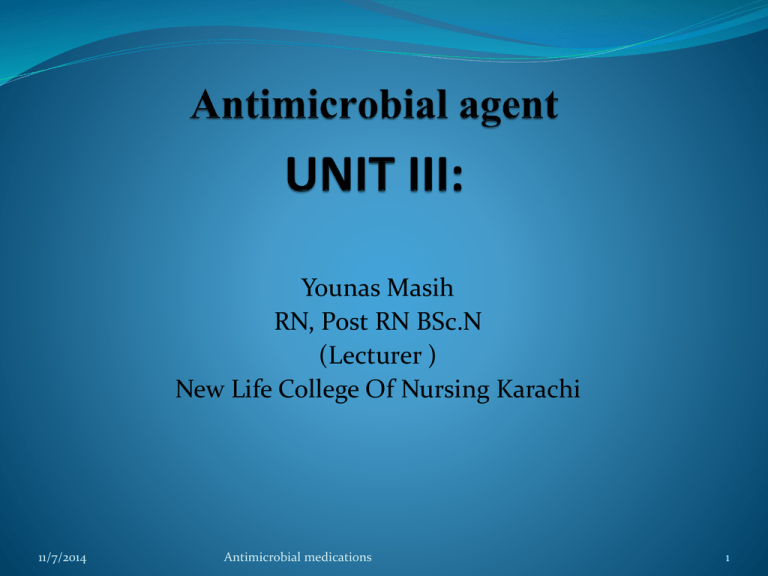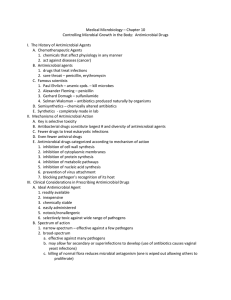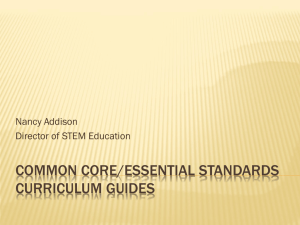Antimicrobial agent year 1
advertisement

Younas Masih RN, Post RN BSc.N (Lecturer ) New Life College Of Nursing Karachi 11/7/2014 Antimicrobial medications 1 Objectives By the end the unit students will be able to: 1. Discuss and review common terms and concepts related to antimicrobial therapy. 2.Discuss mechanism of action and indication of using antimicrobial therapy. 3. State appropriate nursing implications for a client receiving antimicrobial drugs. 4. Discuss general principles and consideration related to antimicrobial therapy. 5. Calculate the drug dosage for oral and parental antimicrobial drugs. 11/7/2014 Antimicrobial medications 2 Terms Antimicrobial agent It is a chemical substance derived from a biological source or produced by chemical synthesis that kills or inhibits the growth of microorganisms. Before antimicrobials, large number of people died from common illnesses Now many illnesses easily treated with antimicrobials However, many antimicrobial drugs are becoming less useful. 11/7/2014 Antimicrobial medications 3 Antimicrobial drugs Different types of antimicrobial drugs: Antibacterial drugs Antifungal drugs Antiprotozoan drugs 11/7/2014 Antimicrobial medications 4 Antibiotics Antibiotic It is a chemical substance produced by a microorganism that inhibits the growth of or kills other microorganisms. Or A chemical substance derivable from a microorganism or produced by chemical synthesis that kills or inhibits microorganisms and cures infections. 1. Bacteriostatic: inhibit growth of microorganisms 2. Bactericidal: Kill microorganisms 11/7/2014 Antimicrobial medications 5 Sources of Antibacterial Agents Natural - mainly fungal sources(The original antibiotics were derived from fungal sources. These can be referred to as “natural” antibiotics) e.g. Benzylpenicillin and Gentamicin are natural antibiotics Semi-synthetic - chemically-altered natural compound (developed to decrease toxicity and increase effectiveness). E.g . Ampicillin and Amikacin are semi-synthetic antibiotics Synthetic - chemically designed in the lab(bacteria are not exposed to the compounds until they are released. They are also designed to have even greater effectiveness and less toxicity). E.g. Moxifloxacin and Norfloxacin are synthetic antibiotics 11/7/2014 Antimicrobial medications 6 Mechanisms of action of Antibacterial Drugs 1. 2. 3. 4. 5. 11/7/2014 Inhibit cell wall synthesis Inhibit protein synthesis Inhibit nucleic acid synthesis Injury to plasma membrane Inhibit synthesis of essential metabolites Antimicrobial medications 7 Mechanisms of Action -Antibiotics operate by inhibiting crucial life sustaining processes in the organism: the synthesis of cell wall material the synthesis of DNA, RNA, ribosomes and proteins. Target The target of the antibiotic should be selective to minimize toxicity…but all antibiotics are toxic to some degree! Harm the bacteria, not the host 11/7/2014 Antimicrobial medications 8 Bacterial cell 11/7/2014 Antimicrobial medications 9 Staining and Identification Gram Staining In this procedure bacteria are washed with a decolorizing solution after being dyed with crystal violet. On adding a counterstain such as safranin or fuchsine after washing, Gram-negative bacteria are stained red or pink Gram-positive bacteria retain their crystal violet dye. 11/7/2014 Antimicrobial medications 10 11/7/2014 Antimicrobial medications 11 Spectrum of Activity Antimicrobial medications vary with respect to the range of microorganisms they kill or inhibit Narrow-spectrum antimicrobial (Some kill only limited range) : Broad-spectrum antimicrobial (While others kill wide range of microorganisms) 11/7/2014 Antimicrobial medications 12 Adverse Effects 1. 2. 3. 11/7/2014 Allergic Reactions: some people develop hypersensitivities to antimicrobials Toxic Effects: some antimicrobials toxic at high concentrations or cause adverse effects Suppression of normal flora: when normal flora killed, other pathogens may be able to grow to high numbers Antimicrobial medications 13 Selection of the appropriate antibiotic It depends upon knowledge of organism’s natural resistance pharmacological properties of the antibiotic toxicity, binding, distribution, absorption achievable levels in blood, urine previous experience with same species nature of patients underlying pathology patient’s immune status 11/7/2014 Antimicrobial medications 14 Ideal Antibacterial Selective target – target unique Bactericidal – kills Narrow spectrum – does not kill normal flora High therapeutic index – ratio of toxic level to therapeutic level Few adverse reactions – toxicity, allergy Various routes of administration – IV, IM, oral Good absorption Good distribution to site of infection Emergence of resistance is slow 11/7/2014 Antimicrobial medications 15 Effects of Combining Drugs 1. Combinations are sometimes used to fight infections 2. Synergistic: action of one drug enhances the activity of another or vice versa. 3. Antagonistic: activity of one drug interferes with the action of another. 11/7/2014 Antimicrobial medications 16 11/7/2014 Antimicrobial medications 17








